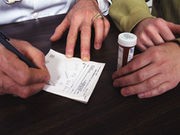

Hoping to stem an epidemic of drug abuse tied to prescription narcotic painkillers such as Oxycontin, Percocet and Vicodin, federal officials on Tuesday issued tough new prescribing guidelines to the nation’s doctors.
The new advisory, from the U.S. Centers for Disease Control and Prevention, stresses that doctors — especially primary care physicians — should try to avoid these addictive “opioid” painkillers whenever possible for patients with most forms of chronic pain.
For example, this would include patients suffering from joint or back pain, dental pain (tooth extraction, for example), or other chronic pain treated in an outpatient setting.
It would not include the use of narcotic painkillers for people dealing with cancer-related pain, or terminally ill patients in palliative care, the CDC said.
“More than 40 Americans die each and every day from prescription opioid overdoses,” CDC director Dr. Tom Frieden said during a Tuesday news conference. “Increased prescribing of opioids — which has quadrupled since 1999 — is fueling an epidemic that is blurring the lines between prescription opioids and illicit opioids,” he added.
Recent reports have sounded alarm bells about the mounting death toll from narcotic painkiller abuse.
In December, the CDC announced that fatal drug overdoses had reached record highs in the United States — driven largely by the abuse of prescription painkillers and another opioid, heroin (many abusers use both).
According to the December report, more than 47,000 Americans lost their lives to drug overdose in 2014, a 14 percent jump from the previous year.
Reacting to the crisis last October, President Barack Obama noted that the daily death toll from drug overdoses now exceeds that of car crashes. At the time, the White House announced a major initiative aimed at combatting the trend. The CDC advisory released Tuesday is a part of that effort.
Besides calling for physicians to try non-narcotic options first for pain relief, the CDC advisory also laid out other steps to curb the abuse of opioid painkillers.
Whenever these painkillers are prescribed, “the lowest possible effective dosage” should be used, the CDC said.
Also, patients who are on such drugs should be closely monitored to “reassess [patient] progress and discontinue medication if needed,” the agency said.
The CDC said it is aiming the new guidelines at primary care physicians, because those doctors currently write nearly half of all prescriptions for narcotic painkillers.
One expert applauded the new initiative.
“These guidelines raise awareness of the hazards of unscrupulous opioid prescribing, as well as highlight the value of non-opioid medications and non-pharmacologic therapies,” said Dr. Harshal Kirane, who directs addiction services at Staten Island University Hospital in New York City.
“The opioid abuse epidemic can impact any of us, so it requires all of us to bring about sustainable change,” he said.
Two studies published Tuesday in the Journal of the American Medical Association highlight the scope of the problem.
In one study, a team led by Dr. Hannah Wunsch, of Sunnybrook Health Sciences Center in Toronto, tracked prescriptions given to American patients after “low-risk” surgeries.
The surgeries included a total of more than 155,000 procedures conducted in the United States for carpal tunnel, gallbladder removal, hernia repair and knee arthroscopy.
Within a week of discharge from the hospital, four out of five patients had filled a prescription for an opioid painkiller, and the vast majority of those prescriptions were for Percocet or Vicodin, the team found.
What’s more, dosages for these drugs tended to rise over time, Wunsch’s team reported, indicating “an increasing reliance on opioids for postoperative pain relief versus alternative therapies.”
A second study focused on another major source of narcotic painkiller prescriptions: Dentists.
That study was led by Dr. Brian Bateman, of Brigham and Women’s Hospital in Boston, and tracked more than 2.7 million patients who’d had a tooth extracted between 2000 and 2010.
According to the study, within a week of having a tooth pulled, 42 percent of patients filled a prescription for a narcotic painkiller. Many of the patients were young: 61 percent of 14- to 17-year-olds filled such prescriptions, the researchers noted.
Bateman’s team believes narcotic painkillers are being overprescribed after tooth extraction, “particularly as non-opioid [painkillers] may be more effective in this setting.”
One expert in dental care wasn’t surprised by the findings.
“A protocol for long-term opioid use is long overdue,” said Dr. Ashish Sahasra, an endodontist at Premier Endodontics in Garden City, N.Y. “Though these pain medications are very necessary, many doctors may tend to overprescribe them in their pain management regimen.”
More information
There’s more on the epidemic of prescription painkiller abuse at the U.S. National Institutes of Health.
Source: HealthDay
Copyright © 2024 HealthDay. All rights reserved.

Leave a Reply